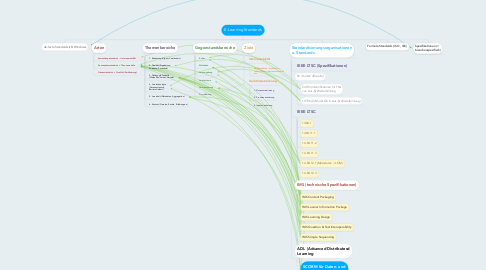E-Learning Standards
저자: Stefan Fersterer


1. de-facto Standards (zB. Windows
2. Arten
2.1. Anwendungsstandards -> Interoperabilität
2.2. Konzeptionsstandards -> Theoriemodelle
2.3. Niveaustandards -> Qualität (Zertifizierung)
3. Themenbereiche
3.1. 1. Bedeutung (allgem. Verständnis)
3.2. 2. Qualität (Ergebnisse, Porzesse, Potentiale)
3.3. 3. Pädagogik-Didaktik (Methoden, Lerner, Umfeld)
3.4. 4. Lerntechnologie (Datenaustausch, Barrierefreiheit)
3.5. 5. Lerninhalt (Metadaten, Aggregation)
3.6. 6. Kontext (Gesetze, Rechte, Erfahrungen)
4. Gegenstandsbereiche
4.1. Rollen
4.2. Methoden
4.3. Lernumgebung
4.4. Lernsysteme
4.5. Lernressourcen
4.6. Durchführung
5. Ziele
5.1. Interoperabilität
5.1.1. zB. Metadaten-, Architektur-, Infrastruktur-, Interfacestandards etc.
5.2. Qualitätsentwicklung
5.2.1. 1. Outputorientierung
5.2.2. 2. Prozessorientierung
5.2.3. 3. Inputorientierung
6. Standardisierungsorganisationen u. Standards
6.1. IEEE LTSC (Spezifikationen)
6.2. SC 36 (der"offizielle)
6.2.1. 24703 (Identifikatoren für TNs von Aus- & Weiterbildung
6.2.2. 19796 (QM und QS in Aus- & Weiterbildung)
6.3. IEEE LTSC
6.3.1. 1484.1
6.3.2. 1484.11.1
6.3.3. 14.84.11.2
6.3.4. 14.84.11.3
6.3.5. 14.84.12.1 (Metadaten = LOM)
6.3.6. 14.84.12.3
6.4. IMS (technische Spezifikationen)
6.4.1. IMS Content Packaging
6.4.2. IMS Learner Information Package
6.4.3. IMS Learning Design
6.4.4. IMS Question & Test Interoperability
6.4.5. IMS Simple Sequencing
6.5. ADL (Advanced Distributesd Learning
6.5.1. SCORM für Daten- und Infoaustausch z.w. LMS
